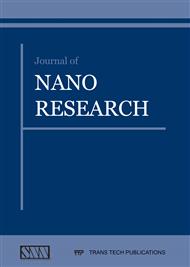[1]
W. Suchanek, M. Yoshimura, Processing and properties of hydroxyapatite-based biomaterials for use as hard tissue replacement implants, Journal of Materials Research 13 (1998) 94-117.
DOI: 10.1557/jmr.1998.0015
Google Scholar
[2]
S.V. Dorozhkin, Calcium orthophosphates in nature, biology and medicine, Materials 2 (2009) 399-498.
DOI: 10.3390/ma2020399
Google Scholar
[3]
Erzsébet-Sára Bogya, Réka Barabás, Alexandra Csavdári, Valentina Dejeu, Hydroxyapatite modified with silica used for sorption of copper(II), Chemiscal paper 63 (2009) 568-573.
DOI: 10.2478/s11696-009-0059-x
Google Scholar
[4]
N. Moayyeri, K. Saeb, E. Biazar, Removal of heavy metals (lead, cadmium, zinc, nickel and iron) from water by bio-ceramic absorbers of hydroxyapatite microparticles, Journal of Marine Science and Engineering 3 (2013) 13-16.
Google Scholar
[5]
L. Donga, Z. Zhua, Y. Qiub, J. Zhaoa, Removal of lead from aqueous solution by hydroxyapatite magnetite composite adsorbent, Chemical Engineering Journal 165 (2010) 827-834.
DOI: 10.1016/j.cej.2010.10.027
Google Scholar
[6]
S. Corami, Mignardi, V. Ferrini, Copper and zinc decontamination from single- and binary-metal solutions using hydroxyapatite, Journal of Hazardous Materials 146 (2007) 164-170.
DOI: 10.1016/j.jhazmat.2006.12.003
Google Scholar
[7]
E. I. Abdel-Gawad, S. A. Awwad, In-vivo and in-vitro prediction of the efficiency of Nano-Synthesized Material in Removal of Lead Nitrate Toxicity, Journal of American Science 7 (2011) 105-119.
Google Scholar
[8]
Y. Takeuchi, T. Susuki, H. A. Arai, Study of equilibrium and mass transfer in processes for removal of heavy metal ions by hydroxyapatite, Journal of Chemical Engineering of Japan 21 (1998) 98-100.
DOI: 10.1252/jcej.21.98
Google Scholar
[9]
E. Mavropoulos, A. M. Rossi, A. M. Costa, Studies on the mechanisms of lead immobilization by hydroxyapatite, Environmental Science and Technology 36 (2002) 1625-1629.
DOI: 10.1021/es0155938
Google Scholar
[10]
Q. Y. Ma, S. J. Traina, T. J. Logan, J. A. Ryan, In situ lead immobilization by apatite, Environmental Science and Technology 27 (1993) 1803-1810.
DOI: 10.1021/es00046a007
Google Scholar
[11]
A. Corami, S. Mignardi, V. Ferrini, Cadmium removal from single- and multi-metal (Cd + Pb + Zn + Cu) solutions by sorption on hydroxyapatite, Journal of Colloid and Interface Science 317 (2008) 402-408.
DOI: 10.1016/j.jcis.2007.09.075
Google Scholar
[12]
M. Lombardi, P. Palmero, K. Haberko, W. Pyda, L. Montanaro, Processing of a natural hydroxyapatite powder: from powder optimization to porous bodies development, Journal of the European Ceramic Society 31 (2011) 2513–2518.
DOI: 10.1016/j.jeurceramsoc.2011.02.017
Google Scholar
[13]
A. Kolmas, A. Jaklewicz, Incorporation of carbonate and magnesium ions into synthetic hydroxyapatite: the efect on physicochemical properties, Journal of Molecular Structure 987 (2011) 40-50.
DOI: 10.1016/j.molstruc.2010.11.058
Google Scholar
[14]
S. Gomes, J. M. Nedelec, E. Jallot, D. Sheptyakov, G. Renaudin, Silicon location in silicate-substituted calcium phosphate ceramics determined by neutron difraction, Crystal Growth and Design, 11 (2011) 4017–4026.
DOI: 10.1021/cg200587s
Google Scholar
[15]
A. Nakahira, C. Karatani, S. Nishida, Evaluation of Cadmium Removal in Solution Using Various Hydroxyapatite and Cattle Bone, Phosphorus Research Bulletin 17 (2004) 148-152.
DOI: 10.3363/prb1992.17.0_148
Google Scholar
[16]
T. Nakahira, T. Okajima, S. Honma, I. Yoshioka, Arsenic Removal by Hydroxyapatite-Based Ceramics, Chemistry Letters 35 ( 2006) 856-857. doi: 10. 1246/cl. 2006. 85.
DOI: 10.1246/cl.2006.856
Google Scholar
[17]
R. Murugan, S. Ramakrishna, K. P. Rao, Nanoporous hydroxy-carbonate apatite scaffold made of natural bone, Materials Letters 60 (2006) 2844–2847.
DOI: 10.1016/j.matlet.2006.01.104
Google Scholar
[18]
Y. Liu, H.Y. Xu, The study of adsorption of Cd2+ by phosphate rocks, ActaMiner. Sin. 3 (2001) 496–508.
Google Scholar
[19]
M. Elena, M.R. Alexandre, M.C. Andea, Studies on themechanisms of lead immobilization by hydroxyapatite, Environ. Sci. Technol. 36 (2002) 1625–1629.
Google Scholar
[20]
L. N. Herbert, M. Christine, B. N. Roberta, E.F. Stephen, J. T. Michael, Bone lead levels in adjudicated delinquents A case control study, Neurotoxicology and Teratology 24 (2002) 711-717.
DOI: 10.1016/s0892-0362(02)00269-6
Google Scholar
[21]
A. Sharma, V. Sharma, L. Kansal, Amelioration of lead-induced hepatotoxicity by Allium sativum extracts in Swiss albino mice, Libyan J. of Med. 5 (2010) 4621-4631.
DOI: 10.3402/ljm.v5i0.4621
Google Scholar
[22]
E. K. Silbergeld, Facilitative mechanisms of lead as a carcinogen, Mut. Res. -Fund. and Mol, Mechanisms of Mutagenesis 533 (2003) 121-133.
DOI: 10.1016/j.mrfmmm.2003.07.010
Google Scholar
[23]
A. Costescu, I. Pasuk, F. Ungureanu, Physico –chemical properties of nano -sized hexagonal hydroxyapatite powder synthesized by sol-gel, Digest Journal of Nanomaterials and Biostructures 5 (2010) 989–1000.
Google Scholar
[24]
D. Predoi, R.V. Ghita, F. Ungureanu, C. C. Negrila, R.A. Vatasescu-Balcan, M. Costache, Characteristics of hydroxyapatite thin ilms, Journal of Optoelectronics and Advanced Materials 9 (2007) 3827–3831.
DOI: 10.1007/978-3-540-95930-4_11
Google Scholar
[25]
A. Belatik, S. Hotchandani, R. Carpentier, H. A. Tajmir-Riahi, Locating the binding sites of Pb(II) ion with human and bovine serum albumins, PLoS ONE 7 (2012) 1-9.
DOI: 10.1371/journal.pone.0036723
Google Scholar
[26]
N. Masakazu, N. Koudai, A. Kenji, Removal of Lead from Contaminated Soils with Chelating Agents, Materials Transactions 49 (2008) 2377-2382.
DOI: 10.2320/matertrans.m-mra2008825
Google Scholar
[27]
S. Bailliez, A. Nzihou, A. Beche, G. Flamant, Removal of Lead (Pb) by Hydroxyapatite Sorbent, Institution of Chemical Engineers. Trans IChemE, Part B, Process Safety and Environmental Protection, 82 (2004) 175–180.
DOI: 10.1205/095758204322972816
Google Scholar
[28]
Dexiang Liao, Wei Zheng , Xiaoming Li , Qi Yang , Xiu Yue , Liang Guo , Guangming Zeng, Removal of lead(II) from aqueous solutions using carbonate hydroxyapatite extracted from eggshell waste, Journal of Hazardous Materials 177 (2010) 126–130.
DOI: 10.1016/j.jhazmat.2009.12.005
Google Scholar


